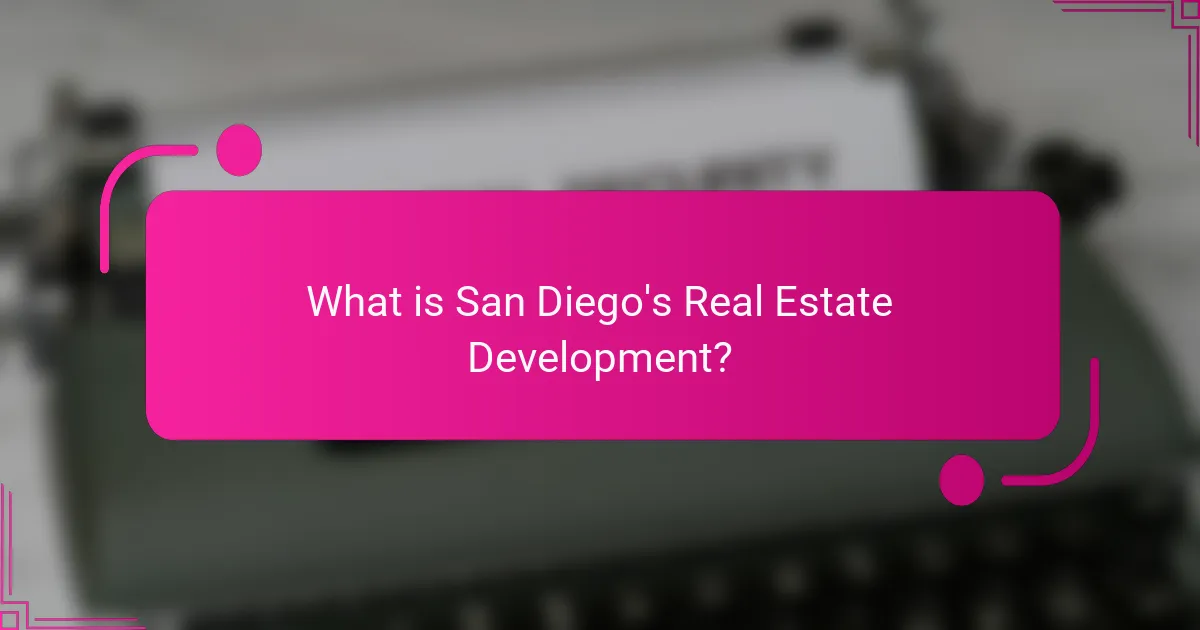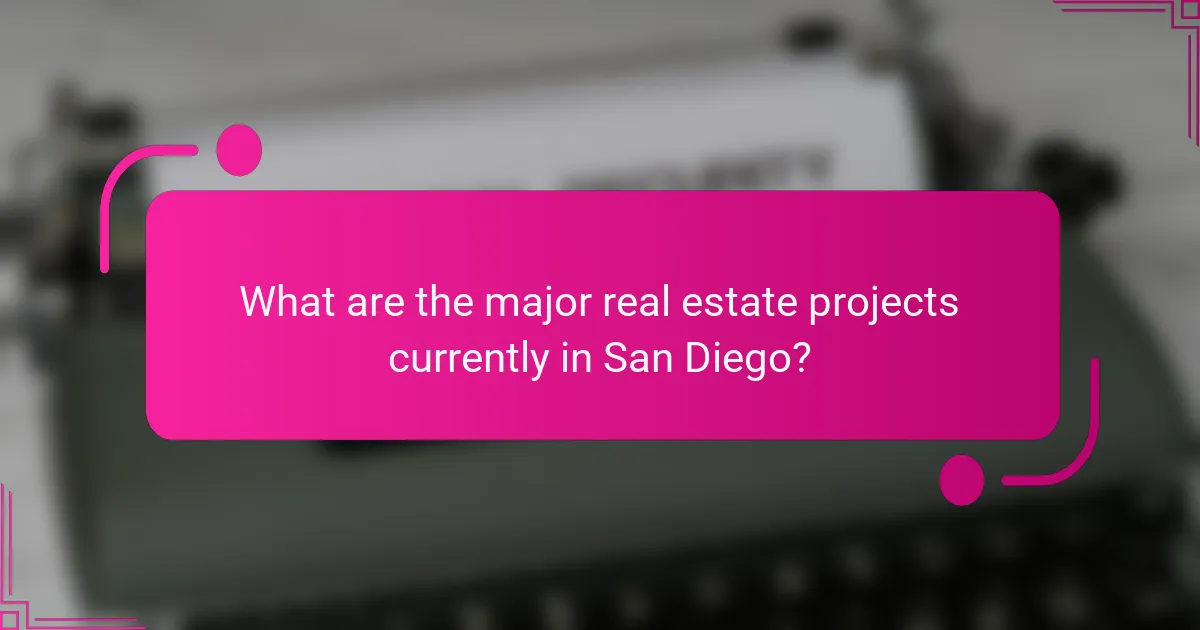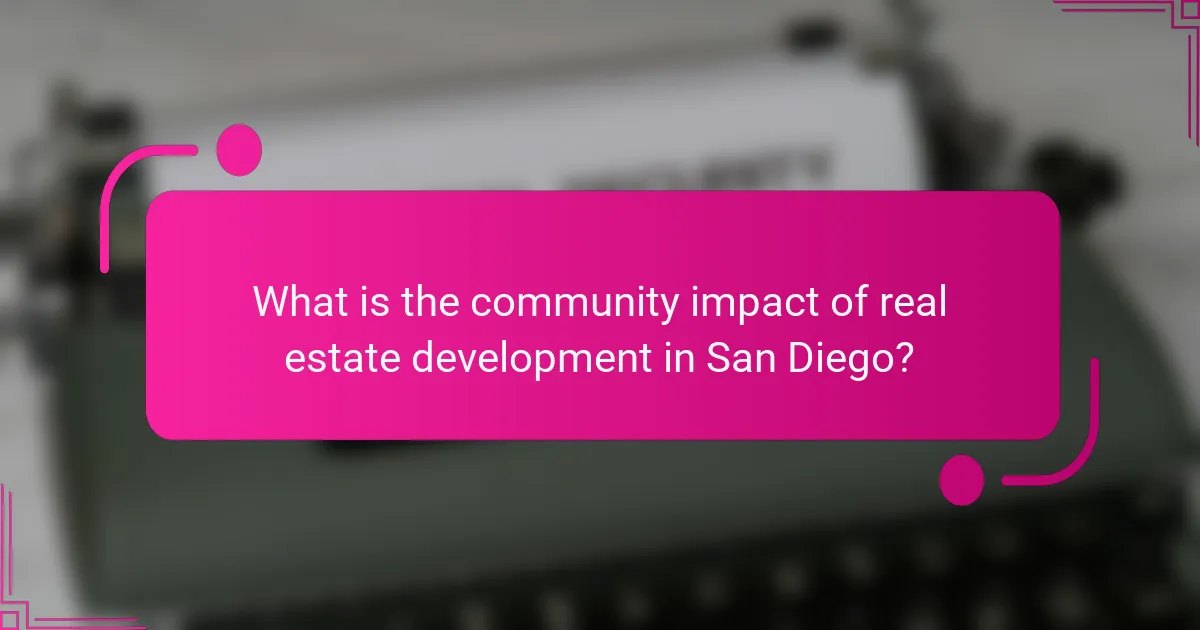
What is San Diego’s Real Estate Development?
San Diego’s real estate development refers to the planning, construction, and management of residential, commercial, and mixed-use properties in the San Diego area. This sector has seen significant growth due to the city’s favorable climate, economic opportunities, and population increase. Major projects include high-rise condos, urban infill developments, and revitalization of waterfront areas. According to the San Diego Association of Governments, the region’s population is expected to grow by over 1 million by 2050, driving demand for housing and commercial spaces. Additionally, trends indicate a shift towards sustainable building practices and community-focused developments. These efforts aim to enhance livability while addressing housing shortages and environmental concerns.
How has San Diego’s real estate development evolved over time?
San Diego’s real estate development has evolved significantly over time. Initially, development focused on residential homes in the early 20th century. The post-World War II era saw a boom in suburban expansion. High-rise buildings began emerging in the downtown area during the 1980s. The 1990s introduced mixed-use developments, blending residential, commercial, and recreational spaces. In recent years, there has been a shift towards sustainable and environmentally-friendly projects. The demand for urban living has increased, leading to revitalization of older neighborhoods. According to the San Diego Association of Governments, the population growth has driven the need for diverse housing options. This evolution reflects changing demographics and economic conditions in the region.
What historical events have shaped San Diego’s real estate landscape?
San Diego’s real estate landscape has been shaped by several historical events. The establishment of the U.S. Navy presence in the late 19th century significantly boosted the local economy. This military influence led to increased demand for housing and commercial properties. The 1915 Panama-California Exposition showcased San Diego, attracting tourism and investment. Post-World War II, a housing boom occurred due to returning veterans and their families. The construction of major freeways in the 1960s facilitated suburban expansion. In the 1990s, the tech boom further transformed the real estate market, increasing property values. Additionally, the 2008 housing crisis temporarily affected the market but led to a recovery and revitalization of urban areas. Each of these events contributed to the evolving nature of San Diego’s real estate development.
How do economic factors influence real estate development in San Diego?
Economic factors significantly influence real estate development in San Diego. Economic growth increases demand for housing and commercial properties. Higher employment rates lead to more disposable income, driving investment in real estate. Interest rates affect borrowing costs for developers. Lower rates encourage more construction projects. Additionally, land prices and zoning regulations impact development feasibility. In San Diego, the cost of land has risen due to limited supply. This creates challenges for affordable housing development. Furthermore, local and state policies can incentivize or hinder development projects. Overall, economic conditions shape the landscape of real estate development in the region.
What are the key components of San Diego’s real estate development?
The key components of San Diego’s real estate development include zoning regulations, market demand, infrastructure, and financing. Zoning regulations dictate land use and development types. Market demand influences project feasibility and pricing. Infrastructure encompasses transportation, utilities, and public services essential for development. Financing involves securing funds through loans or investments. These components shape the landscape and growth of San Diego’s real estate. For example, the San Diego Association of Governments reports ongoing investments in infrastructure to support urban development.
What types of properties are being developed in San Diego?
Residential properties, commercial spaces, and mixed-use developments are being developed in San Diego. The residential sector includes single-family homes, apartments, and condominiums. Notable projects are aimed at increasing housing supply in urban areas. Commercial developments focus on office buildings, retail spaces, and hospitality venues. Mixed-use projects combine residential, commercial, and recreational spaces to enhance community living. Recent trends indicate a push for sustainable and eco-friendly designs in these developments. The city is also prioritizing affordable housing initiatives to address the growing demand.
How do zoning laws impact real estate projects in San Diego?
Zoning laws significantly impact real estate projects in San Diego by regulating land use and development density. These laws dictate what types of buildings can be constructed in specific areas. For instance, zoning can restrict residential, commercial, or industrial developments in certain neighborhoods. This can influence project feasibility and investment potential.
In San Diego, zoning regulations also determine building height, setbacks, and lot coverage. These factors directly affect the design and scale of real estate projects. Additionally, zoning laws can facilitate or hinder community development initiatives. They often require public hearings and compliance with environmental regulations.
Data from the San Diego Planning Department shows that zoning changes can lead to increased housing supply or preservation of historical sites. Therefore, understanding local zoning laws is crucial for developers and investors in San Diego’s real estate market.

What are the major real estate projects currently in San Diego?
The major real estate projects currently in San Diego include the Waterfront Park, the Manchester Pacific Gateway, and the 40th Street Residential Development. Waterfront Park spans 12 acres and features gardens, playgrounds, and event spaces. Manchester Pacific Gateway is a mixed-use development with offices, hotels, and retail spaces, set to revitalize the downtown waterfront. The 40th Street Residential Development aims to provide affordable housing options with over 200 units planned. These projects reflect San Diego’s commitment to urban development and community enhancement.
Which projects are considered landmark developments in San Diego?
Landmark developments in San Diego include the San Diego Central Library, Petco Park, and the USS Midway Museum. The San Diego Central Library, completed in 2013, is notable for its innovative design and community space. Petco Park, opened in 2004, transformed the East Village and revitalized the area. The USS Midway Museum, established in 2004, attracts millions of visitors annually to the historic aircraft carrier. Other significant projects include the Gaslamp Quarter renovations and the ongoing development of the Waterfront Park. Each project has contributed to San Diego’s urban landscape and cultural identity.
What are the features of the most significant developments?
The features of the most significant developments in San Diego’s real estate include mixed-use spaces, sustainable design, and community integration. Mixed-use developments combine residential, commercial, and recreational spaces to create vibrant neighborhoods. Sustainable design incorporates eco-friendly materials and energy-efficient systems, aligning with environmental goals. Community integration ensures developments meet local needs and enhance public spaces. Notable projects, such as the East Village and Waterfront Park, exemplify these features by promoting accessibility and community engagement. These developments contribute to urban revitalization and economic growth in the region.
How do these projects contribute to the local economy?
Real estate development projects significantly boost the local economy. They create jobs in construction, management, and maintenance. For instance, a major project can employ hundreds of workers during its construction phase. This influx of jobs increases local spending and supports businesses. Additionally, new developments often lead to increased property values. Higher property values contribute to greater tax revenues for local governments. This additional revenue can be invested in public services and infrastructure. Furthermore, these projects can attract new residents and businesses, enhancing community growth. A study from the Urban Land Institute found that every $1 million invested in construction generates approximately 17 jobs.
What trends are emerging in San Diego’s real estate market?
San Diego’s real estate market is experiencing several emerging trends. There is a notable increase in demand for multi-family housing. This trend is driven by a growing population and a shift towards urban living. Additionally, luxury home sales are on the rise, reflecting an influx of high-income buyers. The market is also seeing a surge in sustainable building practices. Developers are increasingly incorporating eco-friendly materials and energy-efficient designs. Furthermore, remote work is influencing housing preferences, with buyers seeking homes that accommodate home offices. Finally, there is a growing interest in mixed-use developments that combine residential, commercial, and recreational spaces. These trends indicate a dynamic and evolving real estate landscape in San Diego.
How is sustainability influencing real estate development in San Diego?
Sustainability is significantly influencing real estate development in San Diego. Developers are increasingly incorporating eco-friendly practices into their projects. This includes the use of renewable energy sources and sustainable materials. Additionally, there is a strong emphasis on reducing carbon footprints. The city has set ambitious goals for greenhouse gas emissions reduction. As a result, many new developments are designed with energy efficiency in mind. Green building certifications, such as LEED, are becoming standard. These practices not only enhance property value but also attract environmentally conscious buyers. The trend towards sustainability is reshaping the landscape of San Diego’s real estate market.
What role does technology play in shaping new developments?
Technology plays a critical role in shaping new developments in San Diego’s real estate sector. It enhances project efficiency through advanced planning and design software. Building Information Modeling (BIM) allows for better visualization and coordination among stakeholders. Smart building technologies improve energy efficiency and sustainability in new projects. Additionally, data analytics helps developers understand market trends and consumer preferences. The integration of technology streamlines construction processes, reducing costs and timelines. Innovations like virtual reality enable potential buyers to experience properties before completion. Overall, technology is a driving force behind modernizing real estate development in San Diego.

What is the community impact of real estate development in San Diego?
Real estate development in San Diego significantly impacts the community. It influences housing availability, with new projects often increasing the number of residential units. This can lead to more affordable options for residents. Additionally, development stimulates local economies by creating jobs during construction and in new businesses.
Infrastructure improvements are frequently associated with these projects, enhancing transportation and public services. However, development can also lead to gentrification, displacing long-term residents. Environmental impacts are a concern as well, with potential effects on local ecosystems.
Community engagement is essential in the development process to address these challenges. Studies show that involving residents can lead to more sustainable and accepted outcomes. The balance of benefits and drawbacks defines the overall community impact of real estate development in San Diego.
How does real estate development affect local communities?
Real estate development significantly impacts local communities. It can lead to economic growth by creating jobs and increasing local tax revenues. New developments often provide housing options, which can address shortages in urban areas. However, they may also contribute to gentrification, displacing long-term residents. Infrastructure improvements, such as roads and public services, often accompany new projects. Community amenities, like parks and retail spaces, can enhance quality of life. Studies show that well-planned developments can foster community engagement and cohesion. In contrast, poorly managed projects may lead to increased traffic and environmental concerns.
What are the social implications of new developments?
New developments in San Diego’s real estate significantly impact social structures. They often lead to increased housing availability, affecting affordability. As new projects emerge, they can displace existing communities, causing social tension. Development can enhance local infrastructure, improving access to services like schools and healthcare. This can lead to improved quality of life for some residents. However, it may also exacerbate inequality, as wealthier newcomers may drive up costs. Ultimately, the social implications of new developments are complex and multifaceted, requiring careful consideration of community needs.
How do residents perceive ongoing and upcoming projects?
Residents generally perceive ongoing and upcoming projects in San Diego with a mix of optimism and concern. Many appreciate the potential for economic growth and improved infrastructure. However, some residents express worries about increased traffic and changes to community character. Surveys indicate that about 60% of residents support new developments, citing job creation as a key benefit. Conversely, approximately 40% voice concerns regarding environmental impacts and housing affordability. This duality in perception highlights the need for ongoing community engagement in the planning process.
What strategies can developers use to engage communities?
Developers can engage communities through transparent communication and active collaboration. By hosting community meetings, developers can gather input and address concerns. Utilizing social media platforms allows for real-time updates and feedback. Developers can also partner with local organizations to foster trust and build relationships. Implementing community benefit agreements can ensure that projects meet local needs. Providing educational workshops can inform residents about development processes. Lastly, showcasing project designs through visual aids helps to visualize impacts and benefits. These strategies promote inclusivity and ensure community voices are heard in real estate development.
How can community feedback be integrated into development plans?
Community feedback can be integrated into development plans through structured engagement processes. These processes include public meetings, surveys, and focus groups. Engaging residents early in the planning phase fosters transparency. It allows developers to understand community needs and preferences. Incorporating feedback can lead to more acceptable and successful projects. Studies show that projects with community input often face fewer objections. For example, the San Diego Planning Department emphasizes community input for effective urban planning. This approach enhances trust and collaboration between developers and residents.
What best practices should be followed in San Diego’s real estate development?
Best practices in San Diego’s real estate development include community engagement, sustainable design, and compliance with local regulations. Engaging the community ensures that developments meet the needs of residents. Sustainable design practices reduce environmental impact and promote energy efficiency. Compliance with zoning laws and building codes is essential for legal approval. Utilizing mixed-use developments can enhance urban living. Additionally, incorporating affordable housing options addresses local housing shortages. Monitoring market trends helps developers make informed decisions. Finally, collaborating with local governments and organizations fosters positive relationships and supports community goals.
San Diego’s real estate development encompasses the planning, construction, and management of various properties, including residential, commercial, and mixed-use spaces. The article examines the evolution of this sector, highlighting historical influences, economic factors, and key components such as zoning laws and infrastructure. It also explores major ongoing projects, emerging trends like sustainability and technology integration, and the community impact of development, including housing availability and social implications. By addressing community engagement strategies and best practices, the article provides a comprehensive overview of the current landscape of San Diego’s real estate development.